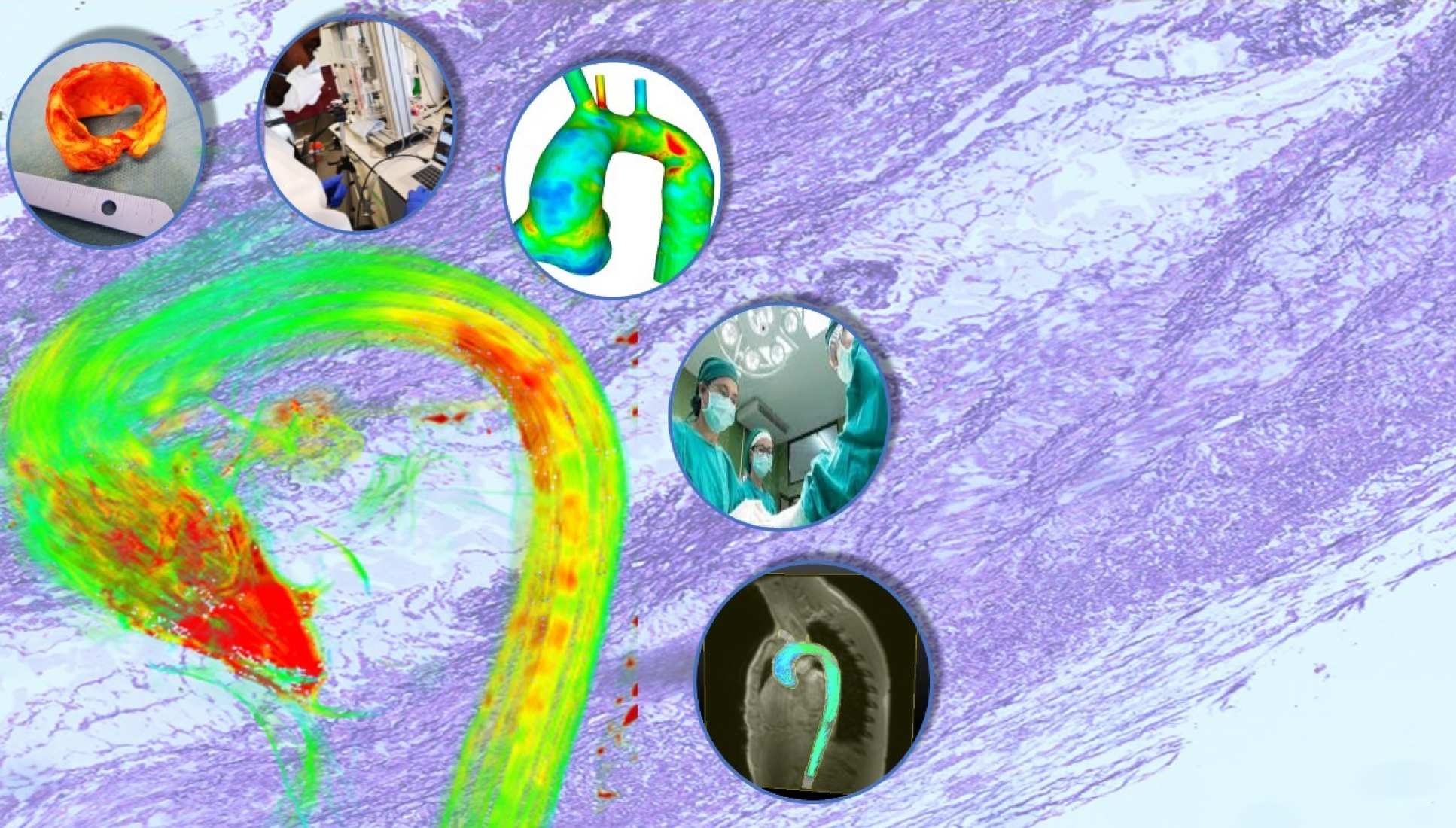
Contact
Professor Thanos Athanasiou
t.athanasiou@imperial.ac.uk
Dr Yousuf Salmasi
y.salmasi@imperial.ac.uk
What we do
The vision of our research group is to improve the diagnostic and treatment process of patients with thoracic aortic aneurysms at risk of a life-threatening type A aortic dissection. Our research brings together advanced imaging technology with tissue biomechanics, genomics, metabolomics and computational modelling.
Why it is important
Guidelines for the management of proximal thoracic aortic aneurysms are limited to size criteria only, and our understanding of which aneurysms are more vulnerable to suffer from acute dissection/rupture is very limited. Most clinical studies tend to be anecdotal, poorly controlled and lack the scientific backing to make ground-breaking conclusions that may change clinical practice.
Biomechanically, acute aortic events occur due to tears occurring spontaneously in the aortic intima/media, leading to formation of a false lumen, which propagates under the aortic pulse pressure to dissect. The failure of the aortic tissue at the dissection entry site occurs as a result of the haemodynamic loads (from blood flow) exceeding its strength
The current gold standard treatment is surgical replacement of the aneurysmal aorta to ward off the life-threatening complications, although it is reserved for at-risk patients owing to the significant burden of surgery. Endovascular management of the proximal thoracic aorta also shows promise, although is not yet established.
How it can benefit patients
Our research aims to create patient-specific computational models to predict how enlarged thoracic aortas will behave over time and assess the risk of aortic dissection.
Our work provides vital data that will be applied to clinical decision support software systems utilising patient specific algorithms that can be used in the hospital setting. This will be vital for patients coming through the multi-disciplinary team in predicting acute aortic events and making important decisions regarding treatment and its timing.
Summary of current research
Our current studies recruit patients with enlarged thoracic aortas.
Patients undergo pre-operative 4D flow MRI. Using computational fluid dynamics and direct measurements from 4D flow images, patient-specific blood-flow profiles are generated
- Pre-operative blood for targeted genomic testing metabolomics. As well as identify commonly associated genes with TAA, we hope to identify metabolic phenotypes that can potentially act as biomarkers of vulnerable TAAs
- Explanted aneurysm from theatre. This is subjected to regional tensile strength and failure testing. This is coupled with the aforementioned haemodynamic parameters to generate a finite element model to simulate aortic wall biomechanics and predict aortic wall rupture.
- Aneurysm tissue is also analysed histologically using computational pathology methods
- The group is in the process of developing deep learning algorithms working with artificial intelligence experts for medical image analysis and complex neural networks
Other research interests of the group include:
- Quality of Life after Aortic Surgery
- Misdiagnosis of Acute Aortic Syndrome
Connections
Related Centres
Our research group actively recruits patients the following London Cardiac centres:
For patients
Our research group actively engages with patients who suffer from thoracic aortopathy as well as family members. We are happy to answer any questions or provide any useful material regarding your therapy or the research we conduct.
We also strongly recommend the following patient engagement groups which provide contemporary useful information on Aortic Aneurysms and Dissection:
Collaborators
Our working group has strong collaborations with the following centres of expertise:
Our researchers
Our researchers
Prof Thanos Athanasiou (PI)
/prod01/channel_3/media/migration/faculty-of-medicine/Thanos-Athanasiou--tojpeg_1574350251367_x4.jpg)
Prof Thanos Athanasiou (PI)
Professor of Cardiovascular Sciences
Prof James Moore Jr
/prod01/channel_3/media/migration/faculty-of-medicine/James-Moore-Jr--tojpeg_1574350448673_x4.jpg)
Prof James Moore Jr
The Bagrit & RAEng Chair in Medical Device Design
Professor Christoph Nienaber, Royal Brompton
/prod01/channel_3/media/migration/faculty-of-medicine/Professor-Christoph-Nienaber--tojpeg_1574436915877_x4.jpg)
Professor Christoph Nienaber, Royal Brompton
Consultant cardiologist
Professor John Pepper
/prod01/channel_3/media/migration/faculty-of-medicine/Professor--tojpeg_1574945904155_x4.jpg)
Professor John Pepper
Professor of Cardiothoracic Surgery
Dr Declan O’Regan
/prod01/channel_3/media/migration/faculty-of-medicine/Dec--tojpeg_1574417149898_x4.jpg)
Dr Declan O’Regan
Reader in Imaging Sciences, London Institute of Medical Sciences
Dr Jan-Lukas Robertus
/prod01/channel_3/media/migration/faculty-of-medicine/Jan--tojpeg_1574417352533_x4.jpg)
Dr Jan-Lukas Robertus
Pathologist, Cardiac Histopathology, Royal Brompton
Dr Deborah Morris-Rosendahl, Royal Brompton
/prod01/channel_3/media/migration/faculty-of-medicine/Dr-Deborah-Morris-Rosendahl--tojpeg_1574417565022_x4.jpg)
Dr Deborah Morris-Rosendahl, Royal Brompton
Clinical Genetics and Genomics
Professor Aung Oo, Barts Heart Centre
/prod01/channel_3/media/migration/faculty-of-medicine/oo--tojpeg_1574417827120_x4.jpg)
Professor Aung Oo, Barts Heart Centre
Surgeon - Cardiothoracic
Dr Sumesh Sasidharan
/prod01/channel_3/media/migration/faculty-of-medicine/sum--tojpeg_1574418092418_x4.jpg)
Dr Sumesh Sasidharan
Engineering Research Associate
Dr M Yousuf Salmasi
/prod01/channel_3/media/migration/faculty-of-medicine/Yousuf-Salmasi--tojpeg_1574419222185_x4.jpg)
Dr M Yousuf Salmasi
Clinical Research Fellow
Dr Omar Jarral
/prod01/channel_3/media/migration/faculty-of-medicine/Omar-Jarral--tojpeg_1574419813451_x4.jpg)
Dr Omar Jarral
Honorary Clinical Research Fellow
Mr Michael Sabetai
/prod01/channel_3/media/migration/faculty-of-medicine/michael-m-sabetai--tojpeg_1575287915205_x4.jpg)
Mr Michael Sabetai
Consultant cardiac surgeon, St Thomas' Hospital
Mr George Asimakopoulos
/prod01/channel_3/media/migration/faculty-of-medicine/George-Asim--tojpeg_1574945752562_x4.jpg)
Mr George Asimakopoulos
Consultant cardiac surgeon, Royal Brompton Hospital
Mr Richard Gibbs
/prod01/channel_3/media/migration/faculty-of-medicine/richardgibbs_1624441607252_x4.jpg)
Mr Richard Gibbs
Vascular Surgeon, Honorary Clinical Senior Lecturer
/prod01/channel_3/media/migration/faculty-of-medicine/xiao--tojpeg_1574416794859_x4.jpg)
/prod01/channel_3/media/migration/faculty-of-medicine/Selene-Pirola--tojpeg_1574418285913_x4.jpg)
/prod01/channel_3/media/migration/faculty-of-medicine/4--tojpeg_1575288091203_x4.jpg)